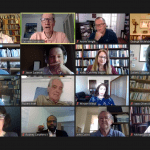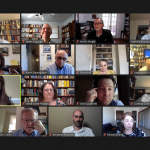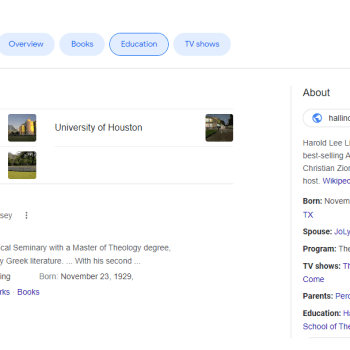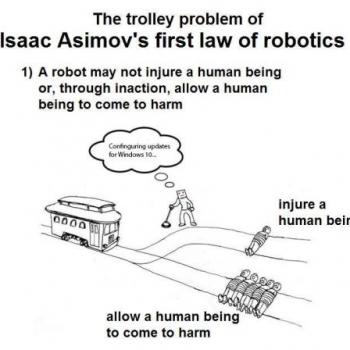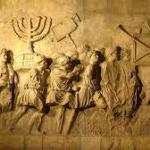The second day began with a look back on the first day of the first ever Enoch Seminar in this format, as well as the substantive content. Archie Wright suggested that even more attention probably deserves to be given to the differing degrees of interest in the garden/Adam and Eve story in different streams of Judaism. The issue of how evil is defined and the extent of interest is also important, as is the use of evil to motivate communities, both present-day confrontation with hostile forces and hope for something ultimate and eschatological. The place of angels in thinking about these matters is also key. Lorenzo Di Tommaso followed by highlighting the different degrees of interest in metaphysical evil and the causes and origins thereof, as well as the different views among groups that have that kind of interest. Another question yet to be answered is whether it is interest in metaphysical evil that sparks the development of apocalyptic, or whether the order is reversed. He also asked what it means to offer a “solution” to the problem of evil, as well as the significance of differences between the kinds of solutions offered. Miryam Bard pointed out that sometimes certain texts are framed as focused on the origin of evil, when in fact the things that are central to them may have been central for different reasons than we think, different than the reasons those things are or could be central to us. Lawrence H. Schiffman followed, expressing how wonderful it is to speak after someone who was his doctoral student. He highlights how certain themes from earlier such as Tiamat and battle with chaos persist without disappearing to reemerge at times, for instance in the magic bowls, as well as in kabbalah. What are the boundaries of monotheism, and of the demonic? That connects directly with my paper that will follow on Thursday, which is about earlier tradition from ancient Israel persisting to reemerge into fuller view in literary form later. John Collins spoke next, followed by Daniel Boyarin, the latter suggesting that he feels the meeting is revisiting an older debate and in fact moving backwards. In his view, the earlier conclusion that apocalyptic is most closely related to Wisdom and deals with revelations of hidden things, whether the weather or evil, is correct. Albert Baumgarten agreed. John Collins emphasized that those who were present at the earlier Nangeroni meeting of the Enoch Seminar at which Boyarin and Baumgarten felt these things were settled were not “we” – many present in the present meeting were not at that earlier one, and certainly do not feel bound by it.
Carol Newsom began the first session focused on new presentations with the Hodayot from Qumran and a side-reference to Philip Pullman. There and in other Dead Sea Scrolls the creation of humans from dust makes them something disgusting. The analogy of humans with vessels, clay, pottery connects directly with ideas about impurity, since pottery vessels cannot be purified and so if they become impure, the only thing left to do is to smash them. From this, the idea that the creation itself is inherently this way emerges, or at least shows that it has already begun to develop. Anthea Portier-Young responded by exploring how this connects with imagery in the Testament of Job, moving from there to comparisons across the Dead Sea Scrolls as well as the Hebrew Bible and New Testament. She then made an analogy between pharmaceuticals and literary typoi, with both at times being applied and put to new uses in ways they were not originally designed to, sometimes with surprising results. James VanderKam went next and started with the general agreement that Jubilees does focus more on evil than its source material Genesis. The idea that evil is already there when humans are created is explored in Jubilees in comparison and contrast with Genesis, and the lack of any idea of original sin. Human acts were felt to provide an unconvincing explanation for evil. God is made ultimately responsible, as the one who appoints spirits over the nations to mislead them, while not doing so with Israel. Lester Grabbe responded, agreeing with the major points VanderKam made. Nonetheless, he isn’t sure that most ancient Jews thought so philosophically as to conclude that if God made rebellious angels, then God caused evil. Grabbe thinks evil is a separate entity from the creator God. Even when for us the implication is that God is responsible, that doesn’t mean ancient readers and authors had the same systematic theological instincts that we do and drew the same conclusion. Florentina Badalanova Geller presented next. In her view in the early Enochic literature it is the lust for the carnal that leads the rebellious angels into error. After that, the revelation of illicit knowledge to angels by those rebellious angels adds still more. She also highlighted the trope of the incubus, bringing her thoughts to a conclusion with focus on 2 Enoch. The violation of the division between the human and divine spheres is a recurring theme. Especially in later tradition, human women receive the propensity of the blame. Matthias Henze responded, originally having been slated to respond to Loren Stuckenbruck who could not participate due to health reasons. He thinks 2 Enoch 18 is not an account of the origin of human sin, and wonders about the appropriateness of filling in gaps in what 2 Enoch says by drawing on 1 Enoch. Henze also mentioned his students’ discomfort with the persistent attempts to blame women, and/or to avoid blaming humanity, when it comes to evil. In Testament of Reuben for example, misogyny reigns, blaming human women for enticing the Watchers. Geller responded by emphasizing that the focus in her paper was not the origin of human evil, but the origin of evil per se. The Watchers are depicted as committing treason, as celestial troops who disobey orders. There was lots of discussion that was rich and fascinating. VanderKam suggested that the author of Jubilees is seeking to distance the origin of evil from heaven (which made me think of the role emanations play in Gnosticism). Henryk Drawnel and Fiodar Litvinau were discussants. Karina Hogan had an interesting question for Carol Newsom about Ben Sira’s use of Job. Newsom suggested that Job’s engagement with Genesis is a subject that deserves a more comprehensive and in-depth study than it has received. Christine Hayes highlighted the inexplicable disruption of a perfect order in so much ancient literature, proposing that ancient people were more interested in narrating the origin of evil than in explanation per se. Gebriele Boccaccini ended the conversation pointing out that there is an emphasis in Jubilees on Israel having a remedy for the problem of evil. The literature does not always systematize or make its assumptions explicit.
Gerbern Oegema started off the afternoon session which focused on evil in non-apocalyptic texts, beginning with the Book of Tobit. Illness caused by demons is the main form of evil the work focuses on, and there are at least three approaches to healing: healing by God, non-religious healing, and pharmaceutical/magical approaches using substances with certain properties. Ben Sira provides a second example. Much changed after the Maccabean revolt. Karina Hogan began by discussing two different religious temperaments outlined by William James before exploring immortality as a denial of the early death of the righteous in Wisdom of Solomon. She revisited a view she articulated in her first published article. Her conclusion is that Wisdom doesn’t deny the existence of evil (the righteous are persecuted by the wicked) but that this creates a genuine problem of theodicy. Greg Sterling said that Philo isn’t consistent, but there is one thing that he emphasizes consistently, namely that God is the source of good but not of evil. On that basis Philo explains the plural in Genesis in reference to the creation of humans, i.e. humans are a mixture of good and evil and the evil must have a source in God’s subordinates. What the powers (which Philo draws from Plato) created was the possibility of evil, and not Evil as a thing that exists objectively. Philo’s bipartite view of the soul is closely connected to this (although he also utilizes Plato’s tripartite system in a similar way). Following the Stoics, Philo adopted a different stance than the Gnostics in not viewing the created material world itself as inherently evil. Hindy Najman considered how the same texts are interpreted in very different ways in connection with the question of evil. We do not need to resolve these questions in order to commit ourselves to doing good and resisting evil. Perhaps we would do better to focus on the struggle with evil, rather than evil as a theological problem, whether ancient or modern. Samuel Adams was next, and brought Stoic influence on Ben Sira back into focus. Ben Wright emphasized how human beings are recognized to be multidimensional, in the interest of absolving God of responsibility for evil. He said he calls the “Billy Graham Rule” the “Ben Sira Rule,” suggesting that ancient author projects on women a lack of self control that he is trying to deny characterizes himself. Erich Gruen said he would offer a change of pace and adopt a literary approach, looking to begin with at the depiction of Antiochus IV as evil and then, bizarrely, as a repentant convert to Judaism who desires to become a missionary. This is mockery, not history nor philosophy. Evil dissolves into farce. A really great example is the depiction of the Devil in Testament of Job. Grappling with evil can be found not only in philosophy but in novels, which diminish evil by parodying and deriding its worst exemplars, reducing it to ridicule. Francis Borchardt was also a discussant and highlighted the connection these ancient texts tend to make between masculinity and goodness and femininity and evil.
The fifth session of the conference asked, “Are evil human or superhuman figures a necessary and functional part of the earliest expressions of evil, or did they develop later?” Ryan Stokes presented first, using plurals in the title of his paper, which focuses on multiple forms of evils, multiple “problems of evils,” and multiple figures brought in to explain and/or narrate about the topic. Where some see divergent theologies, we may be dealing with different focuses, concern with different sorts of evil. Michael Morris responded, further highlighting and exploring that diversity. Kelley Coblentz Bautch emphasized that evil is a constructed category that, like beauty, is in the eye of the beholder. She noted the persistence of early forces of chaos and polytheistic elements can be seen in later works. The disagreements about when evil appears initially and in specific concrete forms are also to be noted. She pointed out that in the current form of the Book of the Watchers and of 1 Enoch, the Watchers are not used to remove culpability from humans. Every good story needs conflict, though not necessarily a villain. What is felt to be theologically and/or logically necessary is not presented as actually the case in every text or system that wrestles with these questions. Angela Kim Harkins, in responding, emphasized our tendency to frame things in terms of this-worldly and other-worldly. She noted that human and angelic figures in many of the texts discussed are mythical, and so does focus on either resolve the problem of evil in a way that absolves humanity? Archie Wright has been working on a monograph on the problem of evil and the reception of the figure of Satan throughout history. The question of whether such figures are real cannot be answered, but the reality of these figures is simply taken for granted by the ancient authors we are talking about. I liked that he used the term “diabology.” He mentioned the desire of theologians in developing orthodoxy to avoid and/or combat the views of Gnosticism. He explored how church fathers resisted Gnosticism in a variety of forms. Augustine emphasized the nature of the Devil as not created evil or with a sinful nature. If sin is natural, Augustine reasoned, it is not sin. He also said that if physical things (fire, water, earth, air) are inherently evil, they must always be evil without exception. Lorenzo DiTomasso responded, emphasizing how central questions of evil are to Patristic authors. Jonathan Ben-Dov was the first respondent in this session, and he focused on what have been called the Dionysiac and Apollonian forces. He also emphasized that myths require superhuman figures, violence, sex, and other things that are characteristic and which appear over and over. He also emphasized the locality of myth, connected with specific places and regions. Turning diverse figures into “Satan” is an effort to domesticate and control those traditions about evil. Joshua Scott, who has also helped manage and oversee sessions, spoke next as discussant. Once it moved to open discussion, Karen King highlighted the importance of the Nag Hammadi literature in relation to this, also drawing attention to Judith Lieu’s work on Marcion. Considering silenced and marginalized ancient voices has direct relevance to contemporary issues. Larry Schiffman emphasized once again the need to take a more complex view and approach to how ideas persist and re-emerge. Leslie Baynes focused on how a particular patristic author “split the difference” between those who posited eternal suffering and the redemption of all things via temporary suffering (apokatastasis).
Rounding things off, Gabriele Boccaccini mentioned that if one attributes evil to rebellion, whether angelic or human, one needs to tell a story with at least one villain. He suggested that we sometimes fail to think about just how remarkable statements like Paul’s, that Satan is “the god of this age,” really are. Archie Wright emphasized how much from second temple Judaism remains present in Christianity beyond any possible “parting of the ways.” Lorenzo DiTommaso emphasized the aim of learning from one another since the entire endeavor of this conference is to connect things that no one of us could ever hope to have full mastery of. That’s what I’ll try to do in my own presentation on the last day, and I’m eagerly looking forward to feedback on it. I don’t know how many will listen to the recording of the 15-minute version I placed on YouTube and linked from the handout on the Enoch Seminar website. But I’ll try to approach the same material in a slightly different manner and structure so that it isn’t simply a repetition for those who may have done so. And hopefully those who listen in advance will be ready with lots more substantive feedback and suggestions as a result!


